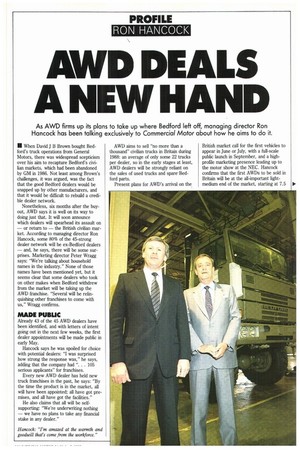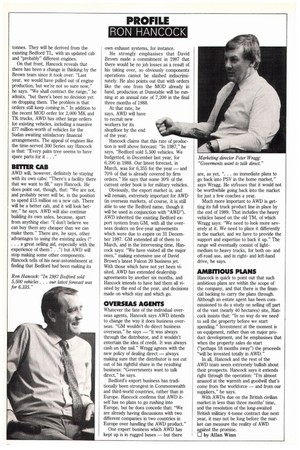AMID DEALS A NEW HAND
Page 61

Page 62

If you've noticed an error in this article please click here to report it so we can fix it.
As AWD firms up its plans to take up where Bedford left off, managing director Ron Hancock has been talking exclusively to Commercial Motor about how he aims to do it.
• When David J B Brown bought Bedford's truck operations from General Motors, there was widespread scepticism over his aim to recapture Bedford's civilian markets, which had been abandoned by GM in 1986. Not least among Brown's challenges, it was argued, was the fact that the good Bedford dealers would be snapped up by other manufacturers, and that it would be difficult to rebuild a credible dealer network.
Nonetheless, six months after the buyout, AWD says it is well on its way to doing just that. It will soon announce which dealers will spearhead its assault on — or return to — the British civilian market. According to managing director Ron Hancock, some 80% of the 45-strong dealer network will be ex-Bedford dealers — and, he says, there will be some surprises. Marketing director Peter Wragg says: "We're talking about household names in the industry." None of those names have been mentioned yet, but it seems clear that some dealers who took on other makes when Bedford withdrew from the market will be taking up the AWD franchise. "Several will be relinquishing other franchises to come with us," Wragg confirms.
MADE PUBLIC
Already 43 of the 45 AWD dealers have been identified, and with letters of intent going out in the next few weeks, the first dealer appointments will be made public in early May.
Hancock says he was spoiled for choice with potential dealers: "I was surprised how strong the response was," he says, adding that the company had ". . . 105 serious applicants" for franchises.
Every new AWD dealer has held new truck franchises in the past, he says: "By the time the product is in the market, all will have been appointed; all have got premises, and all have got the facilities."
He also claims that all will be selfsupporting: "We're underwriting nothing — we have no plans to take any financial stake in any dealer." AWL) aims to sell "no more than a thousand" civilian trucks in Britain during 1988: an average of only some 22 trucks per dealer, so in the early stages at least, AWL) dealers will be strongly reliant on the sales of used trucks and spare-Bedford parts.
Present plans for AWD's arrival on the British market call for the first vehicles to appear in June or July, with a full-scale public launch in September, and a highprofile marketing presence leading up to the motor show at the NEC. Hancock confirms that the first AWDs to be sold in Britain will be at the all-important lightmedium end of the market, starting at 7.5 tonnes. They will be derived from the existing Bedford TL, with an updated cab and "probably" different engines.
On that front, Hancock reveals that there has been a change in thinking by the Brown team since it took over "Last year, we would have pulled out of engine production, but we're not so sure now," he says. "We shall contract the range," he admits, "but there's been no decision yet on dropping them. The problem is that orders still keep coming in." In addition to the recent MOD order for 2,000 MK and TK trucks, AWD has other large orders for existing vehicles, including a massive 277 million-worth of vehicles for the Sudan awaiting satisfactory financial arrangements. The appeal of engines like the time-served 300 Series say Hancock is that: "Every palm tree seems to have spare parts for it . ."
BETTER CAB
AWD will, however, definitely be staying with its own cabs: "There's a facility there that we want to fill," says Hancock. He does point out, though, that: "We are not, and probably never will be, in the position to spend 215 million on a new cab. There will be a better cab, and it will look better," he says. AWD will also continue building its own axles, because, apart from anything else: "I don't believe we can buy them any cheaper than we can make them." There are, he says, other advantages to using the existing axles C' . . . a great selling aid, especially with the experience of them': . .") but AWD will stop making some other components. Hancock tells of his near-astonishment at finding that Bedford had been making its own exhaust systems, for instance.
He strongly emphasises that David Brown made a commitment in 1987 that there would be no job losses as a result of his taking over, so obviously components operations cannot be slashed indiscriminately. He also points out that with orders like the one from the MOD already in hand, production at Dunstable will be running at an annual rate of 7,200 in the final three months of 1988.
At that rate, he says, AWD will have to recruit new workers for its shopfloor by the end of the year.
Hancock claims that this rate of production is well above forecast: "In 1987," he says, "Bedford sold 5,500 vehicles. We budgetted, in December last year, for 6,200 in 1988. Our latest forecast, in March, was for 6,355 for the year — and 70% of that is already covered by firm orders." He says that some 30% of the current order book is for military vehicles.
Obviously, the export market is, and will remain, extremely important for AWD (in overseas markets, of course, it is still able to use the Bedford name, though it will be used in conjunction with "AWD"). AWD inherited the existing Bedford export system from GM, with all the overseas dealers on five-year agreements which were due to expire on 31 December 1987. GM extended all of them to March, and in the intervening time, Hancock says: "We have visited all the major ones," making extensive use of David Brown's latest Falcon 20 business jet. With those which have not yet been visited, AWL) has extended dealership agreements by another six months, and Hancock intends to have had them all visited by the end of the year, and decisions made on which stay and which go.
OVERSEAS AGENTS
Whatever the fate of the individual overseas agents, Hancock says AWD intends to change the way it does business overseas. "GM wouldn't do direct business overseas," he says — "it was always through the distributor, and it wouldn't entertain the idea of credit. It was always cash on the nail." Wragg agrees with the new policy of dealing direct — always making sure that the distributor is not cut out of his rightful share in the resulting business: "Governments want to talk direct," he says.
Bedford's export business has traditionally been strongest in Commonwealth and third-world countries, rather than in Europe. Hancock confirms that AWD itself has no plans to go rushing into Europe, but he does concede that: "We are already having discussions with two different companies in two countries in Europe over handling the AWL) product."
One export business which AWD has kept up is in rugged buses — but there are, as yet, ". . . no immediate plans to go back into PSV in the home market," says Wragg. He stresses that it would not be worthwhile going back into the market for just a few coaches a year.
Much more important to AWD is getting its full truck product line in place by the end of 1989. That includes the heavy vehicles based on the old TM, of which Wragg says: "We need to look more severely at it. We need to place it differently in the market, and we have to provide the support and expertise to back it up." The range will eventually consist of lightmedium to heavy trucks, for both onand off-road use, and in rightand left-hand drive, he says.
AMBRIOUS PLANS
Hancock is quick to point out that such ambitious plans are within the scope of the company, and that there is the financial backing to carry the plans through. Although an estate agent has been commissioned to do a study on selling off part of the vast (nearly 40 hectares) site, Hancock insists that: "In no way do we need to sell the property before we start spending." Investment at the moment is on equipment, rather than on major product development, and he emphasises that when the property sales do start ("perhaps 18 months away") the proceeds "will be invested totally in AWD."
In all, Hancock and the rest of the AWD team seem extremely bullish about their prospects. Hancock says it extends right through the operation: "I'm almost amazed at the warmth and goodwill that's come from the workforce — and from our suppliers," he says.
With AWDs due on the British civilian market in less than three months' time, and the resolution of the long-awaited British military 4-tonne contract due next year, it may not be long before the market can measure the reality of AWL) mainst the promise.
Ul by Allan Winn












































































































